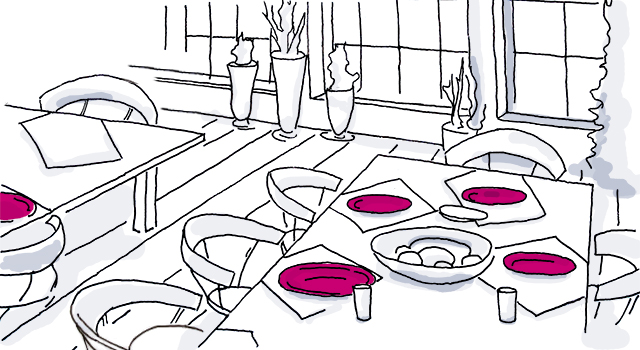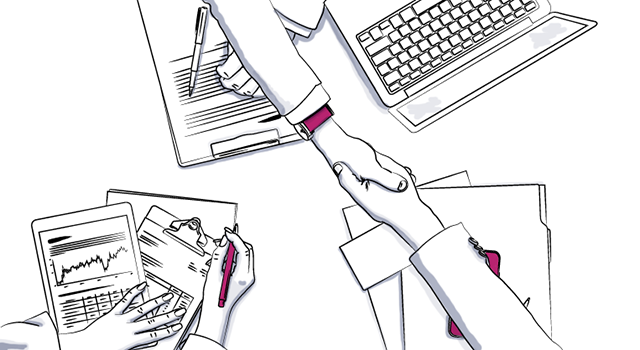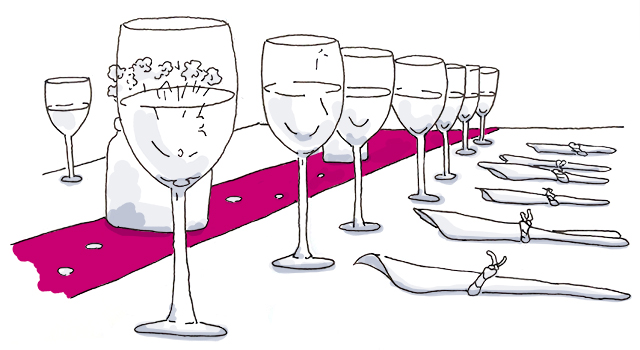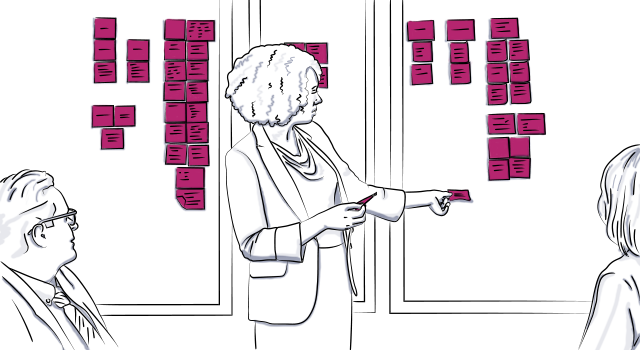
Monday Motivation: Must-Know Event Planning Terminology
The fields of event planning and F&B (that’s Food and Beverage) have a BOA (that’s Bunch Of Acronyms). Read on for a brief primer on key event industry terms so you know your RFP from your BEO.
Explore Event Business Documents & Contracts
The core documents and agreements that establish service agreements and legal responsibilities.
1. BEO – Banquet Event Order
The BEO is a document produced by a venue that will host an event. It lists the order in which events will happen (the ˜event order’ part of the name). The BEO should include exact times; menu details, including special requests; information on vendors like DJs, florists, and caterers; and all equipment needs, from tables to outlets to microphones.
This document usually evolves over the course of planning the event. Before signing the finalized BEO, the planner and client both must review it carefully to ensure it is complete and precise.
2. Force Majeure Clause
This common clause in a contract covers what happens in case of a natural disaster or other ˜Act of God’ that prevents the venue from following through on the contract. Examples include flood, fire, riot, and war¦ things we all reeeeally hope don’t happen, and not just because they’d impact the event.
The clause usually says that in such a circumstance, the venue is not liable for its failure to hold up its side of the contract. The force majeure clause protects both event company and venue”if either is affected by a force majeure event, both parties are off the hook.

3. RFP – Request for Proposal
An RFP is a document an event planner sends to venues describing the event design and asking them to bid on hosting the occasion. RFPs contain details such as space requirements, dates, number of attendees expected, and services required.
An interested venue will respond with a proposal describing how it would meet those needs and at what cost so the planner can compare proposals. If you need guidance, we’ve got you covered with our essential tips for writing event venue RFPs.
Discover Key Event A/V (Audio/Visual) Terms
A/V refers to all the video and audio equipment used at an event: computers, projectors, and video screens for movies or powerpoints; microphones and speakers for presentations or music; lighting, amplifiers, sound mixers.
Depending on the event, A/V needs can be minimal or extensive and highly complex. Successful event planners need to keep up with the technology they use, so they can speak with authority and solve problems on the fly.
Here are some common event planning A/V terms:
1. Aspect ratio
The aspect ratio of a screen is how wide the display is versus how tall. The standard aspect ratio used to be 4:3; now it is more often 16:9 (widescreen). If possible, arrange to have a screen that matches the ratio because it gives presentations a cleaner look.
2. Audio feedback
Feedback is the terrible shriek that comes out of the audio system when the mic picks up noise from the speaker and sends that noise to the amplifier, which makes the noise louder and sends it back out of the speaker again.
Feedback often happens when a mic points at a speaker and is common when an unused mic is left live. If the event has an A/V team, they’ll balance inputs and outputs, track live mics, and eliminate feedback.
3. HDMI cables
HDMI cables are a type of video cable. It is the connection between the device containing the video and the technology used to share that video. For example, an HDMI cable can connect a desktop or laptop computer with a monitor, TV, or projector.
HDMIs are the standard, but there are also other types of video cables, and not every piece of equipment has an HDMI port. If one device has HDMI but the other does not, an adapter is necessary–so plan in advance.
4. Mics: handheld and lavalier
Microphones ensure guests hear the speakers and singers at an event. The lavalier mic is a small wireless mic that may be clipped to the speaker’s clothes, worn as a pendant or mounted on a headset. It’s typically pronounced lava-LEER, rhyming with the word ˜cavalier’.
You’ll also hear people refer to it as a clip mic, clip-on mic, lapel mic, tie mic, body mic, headset, or sometimes just a lav. Some presenters like using a handheld mic and some prefer a lavalier, so ask for preferences. A handheld mic is a must for passing through an audience, though.

Essential Event F&B (Food and Beverage) and Room Setup Terms
F&B is central to the success of any event and makes up a significant portion of the budget. F&B choices must fit the client’s budget and the event goals, and align with the layout of the space.
The setup of any venue is like the skeleton of the event. Just as a cat skeleton won’t work for a bird no matter how nice the feathers, a room with big banquet tables for a sit-down dinner won’t encourage mingling no matter how nice the food.
For the event to make sense, the F&B and the setup should work together toward the event goals. Use free event planning software to help visualize the room setup.
1. All-inclusive catering price
This is what the catering will cost in total. It’s the price to use to compare catering proposals. Start with the per-guest amount, if that’s what the caterer quotes. Calculate the service charge (maybe 20 percent, depending on the company), sales tax (perhaps 8 percent, depending on the area), and a gratuity of 15-20 percent on the original amount (before service charge and tax).
Add them all together, and that total is the all-inclusive price. It can end up being substantially higher than the caterer’s price per head.
2. Banquet round
A large round table often used for meals. Round tables are efficient uses of space because there are no corners that can’t be used for seating. Banquet rounds come in a variety of diameters: 48 rounds comfortably seat six guests; 60 rounds seat eight people; 72 rounds seat 10-12 people. The size of the table will influence both how many guests can fit into a space and the feel of the experience.
For example, 12 guests can fit at either one 72 round or two 48 rounds, but the two smaller tables use more space than one larger table. Small round tables create a more intimate setting when space is not a concern.
3. Banquet setup
A room setup that consists of banquet rounds. Guests face the center of each table; some guests will face away from the front of the room.
4. Cabaret setup
A room set up in which no guests face away from the front of the room. (As if guests were preparing to watch a cabaret.) This setup often uses cabaret tables and is useful when there will be a speaker, presentation, or performance.
5. Cabaret table
A small table, usually between 15 and 36 across, of the kind often seen in coffee shops or theaters. (Or, cabarets!) A smaller cabaret table can seat two guests; larger cabaret tables can seat five people.
6. Catering service charge
The most important thing to know about a service charge is whether it’s included in a caterer’s price quote. If not, you’ll need to do some math to come up with the total cost of catering.
Service charges vary widely by company and location; 18 percent is common, but the top end can climb as high as 49 percent. A service charge covers operational expenses of the catering business; it isn’t the same as a tip.
7. Highboy table
A tall cabaret table, the kind often seen at cocktail hours. People can stand around a highboy or sit with bar-height chairs.
8. Lounge zone
An increasingly popular event seating option that might contain a combination of highboy tables, cabaret tables, ottomans, sofas, and chairs. Lounge zones encourage networking and give attendees a place to refresh and relax less formally.

Stay Up to Date with Event Planning Buzzwords
Lots of event planning buzzwords today fall under the broad category of ˜attendee experience’” an ultra-important component of any event. The desired experience varies by type of event (think about a wedding vs. a product launch vs. a trade show) and attendee interests.
Here are some hot topics in ˜attendee experience’ right now:
1. Personalized / Niche
Many people are looking for personalized experiences that take into account their needs and desires”especially relating to wellness, scheduling options, and food choices. That may mean contracting with a caterer that can meet a variety of dietary needs, or building wellness options into the schedule.
With personalization, attendees feel cared for and that they have a measure of control. This trend toward personalization dovetails with the trend toward niche events that appeal to targeted audiences, such as fans of particular video games or dog breeds.
2. Local / Authentic
Especially when it comes to food, local is most definitely in”locally grown food and local chefs are a draw. This trend dovetails with an increasing interest in authenticity: experiences or cultural interactions authentically tied to a particular locality. Local and authentic items or experiences tend to be especially appealing to millennial audiences.
3. Bleisure
An increasing number of travelers are looking to combine business and leisure travel. There are opportunities here to recommend leisure activities to business event attendees: Enticing ideas can do double-duty, drawing attendees to the event and increasing their enjoyment of it!
When brainstorming ideas, don’t forget the two points above. Recommendations can be tailored to different segments of an event’s likely audience, and local and authentic offerings can generate a lot of interest.
4. AR / VR
AR stands for Augmented Reality; VR for Virtual Reality. Strictly speaking, both depend on headsets that display either a computer-augmented picture of the real world (AR) or a completely virtual world (VR). In the events industry, VR is being used to offer ˜virtual’ attendance at a conference, train people in the use of a product, promote products and services, and more. Headsets that turn smartphones into VR displays are easy to come by. Learn more about augmented reality event planning here.
The bigger question for event planners is how to put the equipment and technology to directed, effective use: Recreation? Welcome experiences? Training? Keep VR possibilities in mind as you brainstorm for your event.
This introduction to event planning terms, jargon, and the most frequent BOAs (Bunch of Acronyms) will have you sounding like a pro in no time. (And the essential event planning checklist will have you planning like a pro.)
One final note: BOA is not a real acronym”only go around using it if you want to be the first!
To keep learning, read about these 6 things to include in every event contract and learn 19 event trends shaking things up this year.
